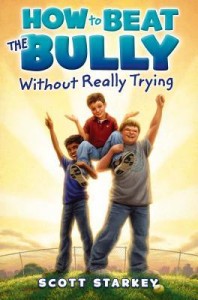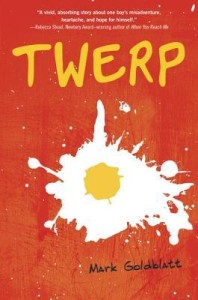I’ll admit it: I cracked up when I read Wimpy Kid. Clearly, my sense of humor is rather juvenile (or, maybe I’ve just spent a LOT of time around middle school kids). I still thought the kid was a jerk, though, and didn’t read any more in the series. I’m currently an intern in an elementary school library and worked in a middle school library last semester; I can tell you that the 3rd-8th graders ARE reading the other books in the series. Several kids asked me anxiously today if the newest book was in yet.
Middle Grade Humor and Pathos
What makes these books (and others like them) so popular with middle grade readers (especially boys)? A strong voice, middle grade angst (boy/girl questions, emerging independence from parents, friend issues, etc.), and plenty of dumb humor. For these reasons, a lot of grown-ups (especially us moms) just groan, roll our eyes, and reach for more “edifying” material. But wait! Your middle grade readers are reading and reading eagerly. Don’t throw out the baby with the bathwater. Here are two novels without Wimpy Kid-style cartoons but which both will draw in middle grade readers ready for more complex material with the same sort of silly humor and middle grade pathos.
How to Beat the Bully Without Really Trying by Scott Starkey. Simon & Schuster, 2012. 258 pgs.
Recommended for: 9-12.
Rodney Rathbone: new kid in a new town and new school. Former victim of bullying in New York, and, frankly, a big coward. But this year is different. Through a freak accident, Rodney appears to have beaten up the school bully on his first day of school (actually, a stray baseball knocked the kid out, but no one saw it except Rodney). Instantly, he’s a hero and the defender of the weak. Bullies don’t take these kinds of upsets lightly, and the remainder of the book shows Rodney escaping one after another of the bullies’ traps (all with the same sort of unbelievable events as the baseball). The bullies include the initial bully, his cronies, and even a couple of teachers!
Frankly, this book reads like an after school special with cheesy scenes, grown-up names that made me groan (“Mrs. Whiner,” “Mrs. Lutzkraut,” the “Windbaggers,” etc.), a touch of romance, and the aforementioned unbelievable narrow escapes. I’m quite sure the average middle grade reader–particularly boys–will find the book amusing. Short chapters will help reluctant readers sail through this big book a bit more easily than otherwise. All in all, it’s inoffensive on the surface, and champions the underdog. A small note: Rodney has to struggle through telling his friends how he really escapes/triumphs or letting them think he’s the superman he appears to be. This is worth discussing with your children; is a lie ever okay? What about not telling the whole truth, lying by omission of details? Deception is a tricky slope, to be sure. [There is a second book in this series–worth noting if you and your child enjoy this first one!]
- Worldview rating (out of 5): 3
- Literary rating: 3
Twerp by Mark Goldblatt. Random House, 2013. 288 pages. Age/interest level: ages 9-12.
Twerp changes the equation up: the narrator is Julian Twerski (“Twerp” for short) and he’s the bully, or at least a partner-in-crime. A more sophisticated book than How to Beat the Bully, Twerp is a rewarding read. Ostensibly, Julian is keeping a journal for his 6th grade English teacher after returning from a week long suspension (having been a 6th grade English teacher, I willingly suspended disbelief that this was actually a 6th grader writing!). Why this assignment? The reader is in suspense until nearly the end of the book, but it’s clear that something happened that Julian should feel badly about.
What the reader finds out along the way is that Julian has some buddies, most notably his best friend Lonnie, who aren’t always the best influence. Reading between the lines, the reader will pick up on some character issues in these friends that Julian himself seems unaware of. The book is often funny, and Julian’s “voice” is very engaging. Set in the late 1960s, the historical setting is a backdrop only. In fact, this book reminded me a lot of Schmidt’s The Wednesday Wars (there are even some Shakespeare references in both books). By the end of the book, Julian is beginning to reflect on who is he, who his friends really are, and how he should think for himself a bit more (instead of always going along with the gang). Discussion points might include these very issues as well as bullying/kindness; all people are made in the image of God, no matter who they are or what they look like.
- Worldview rating (out of 5): 4
- Literary rating (out of 5): 4
What are books that YOUR middle grade readers are enjoying? We’re especially interested in titles that captivate reluctant readers since this age group is often a make-or-break time for learning to love reading.
Middle grade books for boys are a recurring feature here on Redeemed Reader! Check out the following posts for reviews of similar titles: Middle Grade Losers, The Wimpy Kid and His Imitators, and some humorous detective stories.
Cover images from goodreads
Support our writers and help keep Redeemed Reader ad-free by joining the Redeemed Reader Fellowship.
Stay Up to Date!
Get the information you need to make wise choices about books for your children and teens.
Our weekly newsletter includes our latest reviews, related links from around the web, a featured book list, book trivia, and more. We never sell your information. You may unsubscribe at any time.
We'd love to hear from you!
Our comments are now limited to our members (both Silver and Golden Key). Members, you just need to log in with your normal log-in credentials!
Not a member yet? You can join the Silver Key ($2.99/month) for a free 2-week trial. Cancel at any time. Find out more about membership here.
2 Comments
Leave a Comment
You must be logged in to post a comment.




I’ll second the view that Twerp is worthwhile reading, particularly in that it reinforces the view that “There is none righteous.” Julian eventually has to come face to face with his own sins, and recognize that he’s a “quintessence of dust” (there’s the Shakespeare reference). Parents should be warned that there is repeated, though not frequent, use of God’s name, but it often has some spiritual significance, as in this case when the boys have ill-treated a pigeon: “I stared into his eyes, as though he might forgive me for what I’d done to him. But I got nothing back. . . just a look that seemed to be saying ‘I’m a pigeon, for God’s sake. I don’t do stuff like forgive people!'” There’s also some frank discussion of male anatomy, such as what happened when Eric the Red fell off the fence and ended up straddling it. But the moral dimension–by a respected conservative writer, by the way–makes the story worthwhile. “Good guys” can do terrible things if they follow a “great guy” (Lonnie) too closely.
Great addition, Janie! Twerp could have merited its own post for sure.